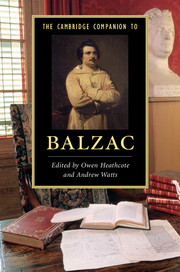56 results
Clinical pharmacology considerations for children supported with ventricular assist devices
-
- Journal:
- Cardiology in the Young / Volume 28 / Issue 9 / September 2018
- Published online by Cambridge University Press:
- 11 July 2018, pp. 1082-1090
-
- Article
- Export citation
External validity and anchoring heuristics: application of DUNDRUM-1 to secure service gatekeeping in South Wales
-
- Journal:
- BJPsych Bulletin / Volume 42 / Issue 1 / February 2018
- Published online by Cambridge University Press:
- 30 January 2018, pp. 10-18
- Print publication:
- February 2018
-
- Article
-
- You have access
- Open access
- HTML
- Export citation
Spatio-temporal influence of tundra snow properties on Ku-band (17.2 GHz) backscatter
-
- Journal:
- Journal of Glaciology / Volume 61 / Issue 226 / 2015
- Published online by Cambridge University Press:
- 10 July 2017, pp. 267-279
-
- Article
-
- You have access
- HTML
- Export citation
11 - Adapting Balzac
-
-
- Book:
- The Cambridge Companion to Balzac
- Published online:
- 09 February 2017
- Print publication:
- 16 January 2017, pp 157-174
-
- Chapter
- Export citation
Guide to Further Reading
-
- Book:
- The Cambridge Companion to Balzac
- Published online:
- 09 February 2017
- Print publication:
- 16 January 2017, pp 200-206
-
- Chapter
- Export citation
Introduction
-
-
- Book:
- The Cambridge Companion to Balzac
- Published online:
- 09 February 2017
- Print publication:
- 16 January 2017, pp 1-10
-
- Chapter
- Export citation
Index of Characters
-
- Book:
- The Cambridge Companion to Balzac
- Published online:
- 09 February 2017
- Print publication:
- 16 January 2017, pp 207-209
-
- Chapter
- Export citation
Contents
-
- Book:
- The Cambridge Companion to Balzac
- Published online:
- 09 February 2017
- Print publication:
- 16 January 2017, pp v-vi
-
- Chapter
- Export citation

The Cambridge Companion to Balzac
-
- Published online:
- 09 February 2017
- Print publication:
- 16 January 2017
Chronology
-
- Book:
- The Cambridge Companion to Balzac
- Published online:
- 09 February 2017
- Print publication:
- 16 January 2017, pp xiv-xvii
-
- Chapter
- Export citation
General Index
-
- Book:
- The Cambridge Companion to Balzac
- Published online:
- 09 February 2017
- Print publication:
- 16 January 2017, pp 210-218
-
- Chapter
- Export citation
Balzac’s Work: an Overview of ‘La Comédie humaine’
-
- Book:
- The Cambridge Companion to Balzac
- Published online:
- 09 February 2017
- Print publication:
- 16 January 2017, pp xviii-xxii
-
- Chapter
- Export citation
Contributors
-
- Book:
- The Cambridge Companion to Balzac
- Published online:
- 09 February 2017
- Print publication:
- 16 January 2017, pp viii-xi
-
- Chapter
- Export citation
Epilogues
-
- Book:
- The Cambridge Companion to Balzac
- Published online:
- 09 February 2017
- Print publication:
- 16 January 2017, pp 189-199
-
- Chapter
- Export citation
Illustrations
-
- Book:
- The Cambridge Companion to Balzac
- Published online:
- 09 February 2017
- Print publication:
- 16 January 2017, pp vii-vii
-
- Chapter
- Export citation
Acknowledgements
-
- Book:
- The Cambridge Companion to Balzac
- Published online:
- 09 February 2017
- Print publication:
- 16 January 2017, pp xii-xiii
-
- Chapter
- Export citation
Abbreviations
-
- Book:
- The Cambridge Companion to Balzac
- Published online:
- 09 February 2017
- Print publication:
- 16 January 2017, pp xxiii-xxiv
-
- Chapter
- Export citation
Copyright page
-
- Book:
- The Cambridge Companion to Balzac
- Published online:
- 09 February 2017
- Print publication:
- 16 January 2017, pp iv-iv
-
- Chapter
- Export citation
Community- and Healthcare-Associated Methicillin-Resistant Staphylococcus aureus Strains: An Investigation Into Household Transmission, Risk Factors, and Environmental Contamination
-
- Journal:
- Infection Control & Hospital Epidemiology / Volume 38 / Issue 1 / January 2017
- Published online by Cambridge University Press:
- 08 November 2016, pp. 61-67
- Print publication:
- January 2017
-
- Article
- Export citation
Alcohol dependence and driving: knowledge of DVLA regulations
-
- Journal:
- BJPsych Bulletin / Volume 39 / Issue 1 / February 2015
- Published online by Cambridge University Press:
- 02 January 2018, pp. 35-38
- Print publication:
- February 2015
-
- Article
-
- You have access
- Open access
- HTML
- Export citation



